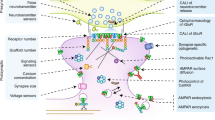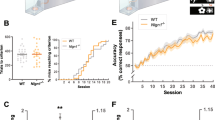Abstract
Learning and decisions are precise functional states of brain cortical circuits that can only be approached by the use of multidisciplinary and complementary tools in behaving animals. The availability of genetically manipulated mice and rats, of mathematical and computational neuroscience methods, and of advanced electrophysiological techniques—susceptible of being applied in behaving animals during the acquisition of different learning paradigms—has largely facilitated this approach. Here, we have recorded activity-dependent changes in synaptic strength in different synapses of hippocampal and prefrontal circuits during the acquisition and storage of classical and instrumental conditioning paradigms. Furthermore, we have developed a dynamic approach of multisynaptic state functions to characterize the acquisition of new motor and/or cognitive skills. In our opinion, a synaptic state function is analogous to a precise picture of synaptic weights while the behaving animal learns the selected task. Therefore, the different state functions of large cortical circuits during the very moment at which learning is taking place could be specifically defined by 3D-arrays of synaptic sites, learning stages, and behaviors. Couplings between the different synaptic state functions are determined by means of weight functions that characterize the changes in synaptic strengths, the type (linear or nonlinear) of interdependences among state functions, as well as the timing and correlation relationships among them. The detailed analysis of the collected data indicates that many synaptic sites within cortical circuits modulate their synaptic strength across the successive stages of acquisition of associative learning tasks. The expected main output of this type of experimental approach would be that learning is the result of the activity of wide cortical and subcortical circuits activating particular functional properties of involved synaptic nodes, and that we can quantify these activation patterns by means of state and weight functions. In this regard, we expect that a map of state functions relating the acquisition of new motor and cognitive abilities and the underlying synaptic plastic changes will be offered in the near future for different types of learning tasks and situations. This same optimized approach could be applied to the selective stimulation of synaptic nodes across the involved circuits, in genetically modified animals, or in animals receiving selective injections of si-RNA, and other molecular-disturbing procedures.
Access provided by Autonomous University of Puebla. Download conference paper PDF
Similar content being viewed by others
Keywords
1 Introduction
It is traditionally accepted that the study of the different neural sites and mechanisms underlying learning and memory processes has to be approached with the help of molecular, histological, and in vitro electrophysiological procedures. Although these experimental approaches have rendered important insides with regard to brain structural and functional properties, they have two important limitations: (i) they use to generate profound alterations of the studied nervous system; and, (ii) they do not report any information on events taking place during the very moment of the acquisition process. In this regard, learning and related cognitive and motor processes should be studied, at the end, at live [1, 2].
Taking into account that neurons are the basic functional elements characterizing the nervous tissue, we would need to know the specific functional properties that the different neural types present in cortical circuits and, very importantly, its functional contribution, moment to moment, to the global process of learning, memory storage, and recall. Thus, each neuronal type in a selected cortical circuit plays a specific role that can only be determined by the use of experimental models allowing its study in the best physiological conditions and during the acquisition of new motor or cognitive abilities. We have developed the basic technology for the study of activity-dependent changes in synaptic strength at a given relay site [1–4]. In this paper, we have extended this information to many different synapses located in hippocampal and prefrontal circuits (see Figs. 1 and 2) during the acquisition and storage of two types of associative (Pavlovian and instrumental) learning tasks in behaving rabbits and rats. We are also introducing here the mathematical tools that will be used in order to obtain relevant data on neuronal network processing during associative learning tasks.
A diagrammatic representation of synaptic weights present in the hippocampal circuit of behaving rabbits during classical conditioning (b, session 1; c, session 8) of eyelid responses using a delay conditioning paradigm. The color code is illustrated in (a). In brief, animals were implanted with stimulating (St.) electrodes in the perforant pathway, the Schaffer collateral/commissural pathway, or in the contralateral CA3 area, and with recording electrodes (Rec.) in the dentate gyrus (DG), and the hippocampal CA3 and CA1 areas. Synaptic activation took place during the CS (tone)—US (air puff) interval
An example of the quantitative analysis for changes in synaptic strength taking place in different hippocampal and prefrontal synapses during the acquisition of an instrumental learning task. (a) Experimental design. The selected synapses were activated when the animal approached to the lever to press it, i.e., when crossing the indicated photoelectric cells. (b) Acquisition curve. (c, d) Synaptic weights (fEPSP slopes) recorded during the first and the seventh training sessions. Abbreviations: BLA basolateral amygdala, mPFC medial prefrontal cortex, NAC nucleus accumbens septi, Sub subiculum
2 Methods
In a first series of experiments, animals (rabbits) were prepared for the chronic recording of the electromyographic activity of orbicularis oculi muscle and of synaptic activity (field excitatory post-synaptic potentials, fEPSPs) evoked at the intrinsic hippocampal circuit or by the stimulation of its main input, i.e., the perforant pathway (Fig. 1). Rabbits were trained with a Pavlovian conditioning protocol (i.e., a classical eyeblink conditioning). Field EPSPs were evoked in the different hippocampal synapses at the interval between conditioned (a tone) and unconditioned (an air puff presented to the cornea) stimulus presentations. The simultaneous recording of synaptic activities at different neural sites offered a still unknown picture of the specific functional states taking place at hippocampal during the actual acquisition process.
In a second series of experiments, Wistar rats were implanted with stimulating and recording electrodes in selected sites of the intrinsic hippocampal circuit and/or in the perforant pathway. Rats were trained in a Skinner box to press a lever in order to obtain a small piece of food. Animals were stimulated at different hippocampal and prefrontal synapses during their performance in the Skinner box task (see Fig. 2).
For analysis, we used here mathematical tools designed in our laboratory to obtain the state functions characterizing the acquisition of new motor and/or cognitive skills. The programs/scripts used here were developed by one of us (R.S.-C.) with the help of MATLAB (The MathWorks, Natick, MA, USA) routines [3].
3 Results
A few years ago, we showed that the hippocampal CA3→CA1 synapse presents a significant change in strength during the acquisition of a type of associative learning task in alert behaving mice: i.e., the classical conditioning of eyelid responses [1, 2]. It was also shown in this study that this learning-dependent change in synaptic strength was linearly related with the rate of acquisition of the conditioned eyeblinks, suggesting a more-or-less direct relationship between the acquisition process and the underlying synaptic plastic changes. At that moment, it was assumed that other synapses present in the intrinsic hippocampal circuit and the many other related to its main inputs (perforant pathway) and outputs (other cortical structures) should present similar changes in synaptic strength [2]. Indeed, we have addressed this question in a recently published study [4] and with different ongoing experiments being carried out in our laboratory. As illustrated in Fig. 1, the different hippocampal synapses present a complex evolution of their synaptic strength across the successive conditioning sessions. Thus, it was clear that each synapse in the hippocampal network contributes in a different way to the acquisition process. In addition, we have carried out a similar classical eyeblink conditioning in behaving mice, including the analysis of fEPSPs changes taking place in nine different hippocampal synapses across conditioning (not illustrated). Here again, changes in synaptic strength across conditioning indicated the presence of a timed and specific plasticity pattern characterizing this type of associative learning.
In Fig. 2 is illustrated a similar experimental approach for the study of synaptic plasticity in behaving animals during another type of associative learning. In this case, we studied changes in fEPSPs evoked at specific synapses connecting the hippocampus, prefrontal cortex, accumbens septi, and the basolateral amygdala (Fig. 2c, d) during the acquisition of an instrumental learning task, using a fixed ratio (1:1) paradigm, i.e., the experimental animal received a small pellet of food every time its pressed a lever (Fig. 2b). Electrical stimulation of the selected synapse was carried out at the moment the rat approached to the lever (Fig. 2a). As illustrated in Fig. 2c, d, there are important changes in synaptic strength in the selected cortical network from the initial conditioning session to the session when the designed task is acquired by the animals.
Finally, in Fig. 3 we present the proposal of a 3D-array of synaptic-learning-behavioral states (Fig. 3a) and the diagrammatic representation of the analytical approach of multisynaptic state functions (Fig. 3b, c). According to this analytical design, two types of matrix can be formed: (1) a matrix for the relationships between different synaptic-learning states during the rth-behavior; and, (2) a matrix for the relationships between different synaptic-behavioral states during the qth-session of conditioning (Fig. 3b). The weight functions (Fig. 3c) determine the strength and type of interdependences among states as well as the timing-causality relationships between them. The prediction error (Fig. 3c) estimates the uncertainties associated with the model and depends on the past values of all the synaptic-learning states. Preliminary results obtained with the analytical procedure suggest the presence of specific spatial-temporal patterns of synaptic weights characterizing each particular learning situation.
Operational 3D-array of state functions. (a) Here, a synaptic state function is analogous to a precise picture of a synaptic pathway while the behaving animal learns the task. Therefore, the different sate functions of large cortical synaptic circuits during the very moment at which learning is taken place could be specifically defined by 3D-arrays of synaptic sites, learning stages, and behaviors. (b) Diagram of the matrices for the synaptic-learning (rth-behavior) and synaptic-behavioral (qth-session) state functions analyses. Two examples of the state functions are presented in the inset (e.g., [8, 4, r] for the rth-behavior; and [5, q, 4] for the qth-session). (c) Mathematical formulation of the multisynaptic state functions for the rth-behavior or the qth-session
4 Discussion
We hope that the present experimental approach will help to offer, in the near future and for the very first time, a complete and quantifiable picture of synaptic events taking place in cortical circuits directly involved in the acquisition, storage, and retrieval of different types of associative learning tasks. Indeed, our experimental approach is susceptible of being used in different types of associative learning as classical and instrumental conditioning, as well in other types of non-associative learning tasks as object recognition and spatial orientation [1–4].
References
Gruart, A., Muñoz, M.D., and Delgado-García, J.M. Involvement of the CA3-CA1 synapse in the acquisition of associative learning in behaving mice. J. Neurosci. (26) (2006) 1077–1087.
Delgado-García, J.M., and Gruart, A. Building new motor responses: eyelid conditioning revisited. Trends Neurosci. (29) (2006) 330–338.
Sánchez-Campusano, R., Gruart, A., and Delgado-García, J.M. Dynamic changes in the cerebellar-interpositus/red-nucleus-motoneuron pathway during motor learning. Cerebellum (10) (2011) 702–710. doi:10.1007/s12311-010-0242.
Jurado-Parras, M.T., Gruart, A., Delgado-García, J.M. Observational learning in mice can be prevented by medial prefrontal cortex stimulation and enhanced by nucleus accumbens stimulation. Learn. Mem. (19) (2012) 99–106.
Author information
Authors and Affiliations
Corresponding author
Editor information
Editors and Affiliations
Rights and permissions
Copyright information
© 2015 Springer Science+Business Media Dordrecht
About this paper
Cite this paper
Delgado-García, J.M., Sánchez-Campusano, R., Carretero-Guillén, A., Fernández-Lamo, I., Gruart, A. (2015). Multisynaptic State Functions Characterizing the Acquisition of New Motor and Cognitive Skills. In: Liljenström, H. (eds) Advances in Cognitive Neurodynamics (IV). Advances in Cognitive Neurodynamics. Springer, Dordrecht. https://doi.org/10.1007/978-94-017-9548-7_61
Download citation
DOI: https://doi.org/10.1007/978-94-017-9548-7_61
Published:
Publisher Name: Springer, Dordrecht
Print ISBN: 978-94-017-9547-0
Online ISBN: 978-94-017-9548-7
eBook Packages: Biomedical and Life SciencesBiomedical and Life Sciences (R0)







